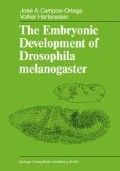Abstract
After a period of successive nuclear divisions the blastoderm is generated from the cleavage nuclei and the egg cytoplasm. The cells of the blastoderm do not show any apparent difference in size and shape; however, there is evidence that these cells are committed to develop into the various segments of the larval and imaginal body (Wieschaus and Gehring 1976, Steiner 1976; see reviews of Sander 1976, Lawrence 1981 a). Along the pages of this book the regularity with which major events of Drosophila embryogenesis occur has been repeatedly emphasized, and this regularity, which had been already recognized a long time ago, suggested to investigators the possibility of establishing a fate map of the blastoderm.
Access this chapter
Tax calculation will be finalised at checkout
Purchases are for personal use only
Preview
Unable to display preview. Download preview PDF.
Author information
Authors and Affiliations
Rights and permissions
Copyright information
© 1985 Springer-Verlag Berlin Heidelberg
About this chapter
Cite this chapter
Campos-Ortega, J.A., Hartenstein, V. (1985). A Fate Map of the Blastoderm. In: The Embryonic Development of Drosophila melanogaster. Springer, Berlin, Heidelberg. https://doi.org/10.1007/978-3-662-02454-6_9
Download citation
DOI: https://doi.org/10.1007/978-3-662-02454-6_9
Publisher Name: Springer, Berlin, Heidelberg
Print ISBN: 978-3-662-02456-0
Online ISBN: 978-3-662-02454-6
eBook Packages: Springer Book Archive

